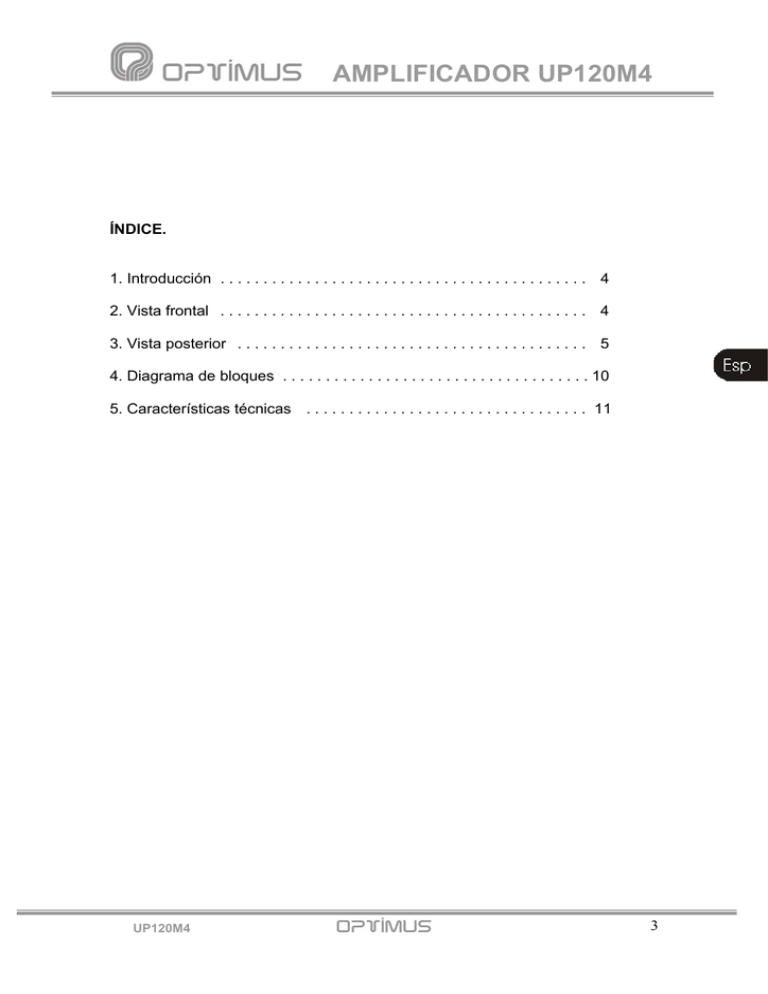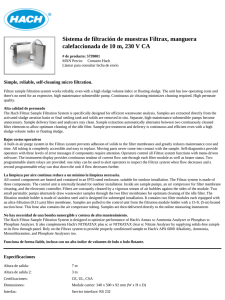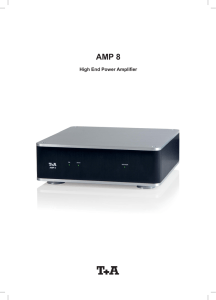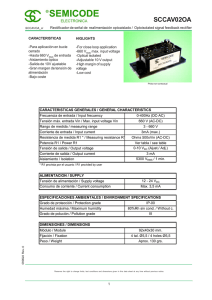amplificador up120m4
Anuncio

AMPLIFICADOR UP120M4 ÍNDICE. 1. Introducción . . . . . . . . . . . . . . . . . . . . . . . . . . . . . . . . . . . . . . . . . . . 4 2. Vista frontal . . . . . . . . . . . . . . . . . . . . . . . . . . . . . . . . . . . . . . . . . . . 4 3. Vista posterior . . . . . . . . . . . . . . . . . . . . . . . . . . . . . . . . . . . . . . . . . 5 4. Diagrama de bloques . . . . . . . . . . . . . . . . . . . . . . . . . . . . . . . . . . . . 10 5. Características técnicas . . . . . . . . . . . . . . . . . . . . . . . . . . . . . . . . . 11 UP120M4 3 AMPLIFICADOR UP120M4 1. INTRODUCCIÓN. El modelo UP-120M4 está constituido por 4 amplificadores de 120 Wats R.M.S. ubicados en un mismo chasis. Indicado para ser utilizado en instalaciones de megafonía, avisos de emergencia, música ambiental y reproducción de la palabra, destacan por su robustez y fiabilidad. Cada amplificador lleva incorporada una protección contra cortocircuito / sobrecarga en la línea de altavoces, así como una protección térmica para evitar averías por calentamiento excesivo. Ocupan 3U en armarios Rack Standard de 19". Se recomienda montar paneles perforados de 1U intercalados. 2. VISTA FRONTAL. (1) INDICADORES DE NIVEL. Indican la potencia entregada a la línea. El LED marcado 0 dB refleja el punto donde el amplificador da la máxima potencia. (2) INDICADORES DE PRIORIDAD. Se iluminan cuando el canal de Priority es seleccionado, es decir: cuando se une el pin n. 6 con el pin n. 8 en el conector RJ45 de la Entrada de Prioridad. Fig. 1 (3) INDICADORES DE PROTECCIÓN. Se iluminan cuando actúa la Protección, pudiendo ser debido a una sobrecarga o cortocircuito en la línea de altavoces. (4) ENTRADA DE VENTILACIÓN. No obstruir bajo ningún concepto. (5) CONTROLES DE VOLUMEN DE ENTRADAS DE PRIORITY. Girándolos en el sentido de las agujas del reloj, aumentan el volumen de los canales de Prioridad. Potenciómetros ajustables con destornillador. (6) CONTROLES DE VOLUMEN DE ENTRADAS DE PROGRAM. Girándolos en el sentido de las agujas del reloj, aumentar el volumen del canal de programa. Potenciómetros ajustables con destornillador. (7) INDICADOR ON/OFF. Se ilumina cuando el amplificador está funcionando tanto en alimentación de Red como de Batería. (8) INTERRUPTOR ON/OFF. Conecta y desconecta el amplificador solo en caso de que esté alimentado por la RED de 230Vca. Si funciona alimentado por batería este interruptor no actúa. 4 UP120M4 AMPLIFICADOR UP120M4 3. VISTA POSTERIOR. (1) RELÉS AUXILIARES DE SEGURIDAD DE AVISOS. Conmutan cuando se activan los correspondientes contactos de prioridad de las entradas de los canales PRIORITY. Fig. 2 (2) SALIDAS LÍNEA DE ALTAVOCES. Las salidas de línea de Altavoces se efectúan mediante transformadores que disponen de salidas de baja impedancia (8 Ohms) y alta Impedancia (70-100 V). La conexión se hace entre el terminal "0" (común) y el correspondiente a la impedancia o tensión escogida. (3) CONEXIÓN A LA RED DE 230 V.c.a. La placa posterior dispone de una base macho para la alimentación CEE22 que permite conectarlo a la red mediante el cable suministrado. Atención: Este aparato no puede estar expuesto al agua o a salpicaduras (4) FUSIBLE DE RED. Se encuentra situado en el cajetín inferior de la base de alimentación. El mismo cajetín contiene fusible de recambio. Fig. 3 (5) ENTRADA ALIMENTACIÓN CON BATERÍA. Esta alimentación permite el uso de estos aparatos en instalaciones de seguridad, conectando una batería de 24 Vcc. El interruptor ON/OFF no corta la alimentación de la batería. (6) CONEXIÓN DE LA MASA AL CHASIS. En toda instalación de megafonía es muy importante que haya un solo punto de unión entre la masa de señal y el contacto de tierra de la red. Si la instalación de megafonía está compuesta por varios aparatos, probablemente tendrán los chasis unidos, bien mediante el terminal de tierra de la conexión a la red, o bien porque estén montados en un armario rack. Si las masas están también unidas por los circuitos de señal, es aconsejable quitar el puente entre la masa y el chasis de todos los aparatos excepto uno. Fig. 3a UP120M4 5 AMPLIFICADOR UP120M4 (7) SALIDA DE VENTILACIÓN No obstruir esta salida bajo ningún concepto. Equipado con un ventilador en la parte posterior, el cual permanece siempre en funcionamiento, modificando su velocidad según la temperatura que va alcanzando el equipo. (8) AJUSTE OSCILADORES OPCIONALES OSC-02 Si en el UP120M4 se han instalado circuitos osciladores OSC-02 (circuitos opcionales necesarios para la supervisión de líneas), estos controles permiten ajustar el nivel de la señal de oscilación. Para efectuar el ajuste, siga los pasos indicados en el manual de la carta DALA-01/DA. El ajuste debe realizarse con la línea de altavoces correspondiente cargada. Colocación de los circuitos osciladores. Siga los pasos que marca la figura 4. Fig. 4 6 UP120M4 AMPLIFICADOR UP120M4 (9) REGLETA PRIORITY CONTROL Estos contactos permiten la activación de la prioridad del amplificador, facilitando el cableado de la instalación. El diagrama de bloques muestra el ejemplo de una instalación con 4 zonas. Cada zona está conectada a una sección, con distinta funcionalidad; ( Ver figura 5). SECCIÓN 1: El selector de zonas activa la prioridad (zona 1). La señal de audio procede del micrófono 1. SECCION 2: El selector de zonas activa la prioridad (zona 2). La señal de audio procede del micro 1 a través de la salida de prioridad de la sección 1. SECCION 3: Prioridad y señal de audio están directamente conectadas al micrófono 2. SECCION 4: El contacto de prioridad es activado por el selector de zonas (zona 4). La señal de audio procede del micro 2 a través de la salida de prioridad de la sección 3. Fig. 5 (10) CANALES DE PRIORIDAD y (11) CANALES DE PROGRAMA. Los dos canales de entrada (PROGRAM y PRIORITY) de cada amplificador utilizan 4 conectores del tipo RJ45 conectados en paralelo 2 a 2. De este modo, pueden proporcionar señal a otras etapas de potencia ( Ver figura 6). Para su conexión debe utilizarse cable STP de Cat 5.La principal característica de este tipo de cable es su muy baja impedancia, de manera que permite una respuesta frecuencial excepcionalmente plana incluso para largas distancias, cumpliendo con las prestaciones de CMRR y "Crosstalk" requeridas para audio analógico. Fig. 6 UP120M4 7 AMPLIFICADOR UP120M4 Las entradas de señal son balanceadas por transformador y tienen una sensibilidad de 0 dBu (775mV).El pin n.º 3 proporciona una tensión de 24 Vcc que puede utilizarse para alimentar dispositivos de bajo consumo. La corriente máxima suministrada es de 200 mA. en cada canal. En el canal de PRIORITY, al unir el pin nº 6 con el pin nº 8 se activa el sistema de prioridad, y se activa el relé auxiliar de seguridad de avisos. A través del pin número 6 del conector PRIORITY OUTPUT, puede transmitirse el control de prioridad a otras etapas de potencia, siempre en función de la posición de los dipswitchs 7 y 8 (Ver apartado 3. VISTA POSTERIOR, núm. 9). Fig. 7 12) DIPSWITCH. SHIELD - GND LINK (dipswitchs núm. 1, 2, 3 y 4). Estos 4 dipswitchs permiten separar la pantalla del cable de la masa interna del aparato para cada uno de los conectores RJ-45. Normalmente están en posición ON (pantalla y masa del aparato unidas). Para separarlas debe situarse el dipswitch correspondiente en OFF. Fig. 8a PRI-PRO LINK (dipswitchs núm. 5 y 6). Estos dos dipswitchs unen internamente la señal de audio H y la señal de audio C (cuando la entrada es balanceada) presentes en la salida de prioridad (PRIORITY OUTPUT) con la entrada de programa (PROGRAM INPUT). Normalmente están en posición OFF(señales de audio separadas). Para unirlas debe situarse el dipswitch correspondiente en ON. PRIORITY CONTROL IN (dipswitch núm. 7) En posición OFF, deshabilita el contacto de prioridad del conector RJ PRIORITY INPUT en su sección pero se mantiene la prioridad en el conector RJ PRIORITY OUTPUT. PRIORITY CONTROL OUT (dipswitch núm. 8). En posición OFF, deshabilita el contacto de prioridad del conector RJ PRIORITY OUTPUT. JPA (dipswitchs num. 9) Colocar en posición OFF cuando el equipo lleva incorporados los osciladores. 8 Fig. 8b UP120M4 AMPLIFICADOR UP120M4 4. CONEXIONADO CON ATENUADORAS UP120M4 9 AMPLIFICADOR UP120M4 5. DIAGRAMA DE BLOQUES 10 UP120M4 AMPLIFICADOR UP120M4 6. CARACTERÍSTICAS TÉCNICAS DE CADA SECCIÓN UP120M4 Potencia de salida R.M.S. 120W Potencia de salida I.H.F. 175W Distorsión armonica total Ancho de banda Relación señal / ruido Entradas Sensibilidad entradas Salida línea de altavoces Controles Alimentación red Alimentación batería Consumo vacío total 4 secciones Consumo plena carga total 4 secciones Activación del ventilador Dimensiones (mm) Unidades de rack Peso Acabados UP120M4 inf. a 0.6% a 1 kHz 55 Hz a 18 kHz 80dB 1 programa (0dB) 1 prioridad (0dB) 775mV ( programa y prioridad) 100V, 70V, 8 ohmios Volúmenes de programa y de prioridad 230 V.c.a 24 V.c.c 56VA 1400VA Ventilación continua, con variación de la velocidad según la temperatura 482 x 360 x 133 mm 3 Unidades 25.3kg Placa frontal de aluminio anodizado negro. Tapa de acero esmaltado negro. 11 UP120M4 AMPLIFIER INDEX 1. Introduction . . . . . . . . . . . . . . . . . . . . . . . . . . . . . . . . . . . . . . . . . . . 13 2. Front view . . . . . . . . . . . . . . . . . . . . . . . . . . . . . . . . . . . . . . . . . . . . 13 3. Rear view . . . . . . . . . . . . . . . . . . . . . . . . . . . . . . . . . . . . . . . . . . . . 14 4. Block diagram . . . . . . . . . . . . . . . . . . . . . . . . . . . . . . . . . . . . . . . . . . 19 5. Technical specifications . . . . . . . . . . . . . . . . . . . . . . . . . . . . . . . . . . 20 12 UP120M4 UP120M4 AMPLIFIER 1. INTRODUCTION. The UP-120M4 model is made up of 4 amplifiers of 120 Watts R.M.S. each, housed in the same frame. Suitable for use in public address installations, emergency paging, background music and speech reproduction systems. Their toughness and reliability must be outlined as well. Each amplifier includes a protection against short-circuits / over-loadings in the loudspeakers line, as well as a thermal protection to avoid damages due to over-heating. They occupy 3U when mounted in a 19” Standard Rack Cabinet. When Rack mounted, it is recommended to install 1U perforated panels between them. 2. FRONT VIEW. (1) LEVEL INDICATORS. To indicate the power delivered to the line. The LED marked as 0 dB indicated the maximum power given by the amplifier. (2) PRIORITY INDICATORS. They light when the Priority channel is selected, it is: when the pin n. 6 is joined to the pin n. 8 in the RJ45 connector of the Priority Input. (3) PROTECTION INDICATORS. They light when the Protection is operating due either to an over-loading or to a short-circuit in the loudspeakers line. Fig. 1 (4) VENTILATION INPUT. Do not obstruct under no circumstances. (5) PRIORITY INPUTS VOLUME CONTROLS. Turn them clockwise to increase the volume of the Priority channels. The potentiometers can be adjusted by using a screwdriver. (6) PROGRAM INPUTS VOLUME CONTROLS. Turn them clockwise to increase the volume of the Program channel. The potentiometers can be adjusted by using a screwdriver. (7) ON/OFF LED INDICATOR. It lights when the amplifier is in operation, either by Battery or Mains. (8) ON/OFF SWITCH. It switches on/off the amplifier only if the power is supplied by the 230 Vac mains. This switch is not operational when the amplifier is supplied by battery. UP120M4 13 UP120M4 AMPLIFIER 3. REAR VIEW. (1) SECURITY PAGING AUXILIARY RELAYS. They are switched when the corresponding priority contacts of the PRIORITY channels are activated. Fig. 2 (2) LOUDSPEAKERS LINE OUTPUTS. The Loudspeakers line outputs are done by means of transformers with low impedance outputs (8 Ohms) and high impedance outputs (70-100 V). The connection is made between the "0" (common) terminal and the one corresponding to the chosen impedance or voltage. (3) CONNECTION TO THE 230 V.a.c. MAINS. The rear panel has a male base for the CEE22 supply which allows its connection to the mains by means of the cable included. Attention: this equipment cannot be splashed or exposed to water. Fig. 3 (4) MAINS FUSE. It is located into the lower box of the power supply base. In the same box there is a replacement fuse as well. (5) BATTERY SUPPLY INPUT. This supply allows the use of these amplifiers in security installations, connecting the same to a 24 V.d.c. battery. The ON/OFF switch doesn't cut the supply from the battery. (6) CONNECTION OF THE GROUND TO THE FRAME. In all P.A. installations, it is very important to have only a joining point between the signal ground and the mains ground contact. If the P.A. installation is made up of several equipments, they will probably have the frames joined either by means of the ground terminal of the mains connection, or because they are mounted in a rack cabinet. If the grounds are also joined by the signal circuits, it is advisable to remove the jumper between the ground and the frame of all equipments excepting one. Fig. 3a 14 UP120M4 UP120M4 AMPLIFIER (7) VENTILATION OUTPUT. Do not obstruct this output under no circumstances. There is a fan in the rear panel, always in operation, changing its speed depending on the temperature reached in the equipment. (8) ADJUSTMENT OF OPTIONAL OSCILLATORS. If OSC-02 (optional circuits needed for the lines supervision) are installed into the UP120M4, these controls allow adjusting the oscillation signal level. To do the adjustment, follow the steps indicated in the manual of the DALA-01/DA card. The adjustment must be done with the corresponding loudspeakers line loaded. Place the oscillators circuits. Follow the steps shown in the figure 4 Fig. 4 UP120M4 15 UP120M4 AMPLIFIER (9) PRIORITY CONTROL TERMINAL BLOCK These contacts allow the activation of the amplifier priority, facilitating the installation wiring. The block diagram shows an example of installation with four zones. Each zone is connected to one section with different functions; (See figure 5). SECTION 1. The zones selector activates the priority (zone 1). The audio signal is given by micro 1. SECTION 2. The zones selector activates the priority (zone 2). The audio signal comes from microphone 1 trough the priority out of section 3. SECTION 3. The priority contact and audio signal are directly connected to microphone 2. SECTION 4. The priority contact is activated by the zones selector (zone 4). The audio signal comes from micro 2 from the priority output of the section 3. Fig. 5 (10) PRIORITY CHANNELS & (11) PROGRAM CHANNELS. The two input channels (PROGRAM & PRIORITY) from each amplifier use 4 RJ45 type connectors in parallel 2 to 2. This way, they can provide signal to other power units (see figure 6). For the connection, you must use STP Cat 5 cable, which main feature is that it has a very low impedance, which allows to have an exceptionally flat frequency response even for long distances, and to comply with the CMRR & Crosstalk features required for the analogical audio systems. Fig. 6 16 UP120M4 UP120M4 AMPLIFIER The signal inputs are balanced by transformer and have a sensitivity of 0 dBu (775mV). The pin n.º 3 provides a 24 Vdc voltage which can be used to supply devices of low consumption. The maximum intensity supplied is of 200 mA in each channel. In the PRIORITY channel, when joining the pin º 6 to the pin nº 8, the priority system is activated as well as the security paging auxiliary relay. It is possible to transmit the priority control to other power units through the pin nº 6 of the PRIORITY OUTPUT connector, always depending on the position of the dipswitches 7 & 8 (see section 3. REAR VIEW, nº 9). Fig. 7 12) DIPSWITCH. SHIELD - GND LINK. (dipswitches nº 1, 2, 3 & 4). These 4 dipswitches allow removing the cable shielding from the internal ground of the equipment for each one of the RJ-45 connectors. Normally they are in ON position (shielding and ground joined). To separate the same, place the corresponding dipswitch in OFF position. Fig. 8a PRI-PRO LINK (dipswitches nº 5 & 6). These two dipswitches join internally the H audio signal and the C audio signal (when the input is balanced) that are in the PRIORITY OUTPUT with the PROGRAM INPUT. Normally they are in OFF position (separated audio signals). To join the same, place the corresponding dipswitch in ON position. PRIORITY CONTROL IN (dipswitch nº 7). In OFF position, it disables the priority contact of the RJ PRIORITY INPUT connector. PRIORITY CONTROL OUT (dipswitch nº 8). In OFF position, it disables the priority contact of the RJ PRIORITY OUTPUT connector. JPA (dipswitch nº 9). Put OFF when the equipment includes the oscillators. Fig. 8b UP120M4 17 UP120M4 AMPLIFIER 4. CONNECTION WITH ATTENUATORS. 18 UP120M4 UP120M4 AMPLIFIER 5. BLOCK DIAGRAM UP120M4 19 UP120M4 AMPLIFIER 6. TECHNICAL SPECIFICATIONS OF EACH SECTION UP120M4 R.M.S. Ouput power 120W I.H.F. Output power 175W Total harmonic distortion Frequency response Signal / Noise ratio Inputs Inputs sensitivity Loudspeakers line output Controls less than 0.6% at 1 kHz 55 Hz at 18 kHz 80dB 1 program (0dB) 1 priority (0dB) 775mV (program & priority) 100V, 70V, 8 ohms Program and Priority volumes Mains supply 230V ac Battery supply 24V dc Stand-by consumption, total 4 sections Rated output consumption, total 4 sections Fan activation Dimensions (mm) 56VA 1400VA Continuous ventilation, with variation according to the temperature speed 482 x 360 x 133 mm Rack units 3 units Weight 25.3 kg Finishing 20 Front panel in anodised black aluminium Cover in black enamelled steel. UP120M4 ADDENDA 1 1 20/12/2005 2 3 4 7 6 8 9 10 11 12 FIGURE 3a (pag. 14) / FIGURA 3a (pag. 5) 5 4. CONNECTION WITH ATTENUATORS (pag. 18) / CONEXIONADO CON ATENUADORAS (pag. 18) AV4 + LINE 2 LINE 1 PRIORITY 24V. + - + - + - + - + 5 OUT 6 4 24V 1 2 3 AV4P S -C LINE 3 LINE 6 REGULATED OUTPUT LINE 5 6 CHANNELS WITH PRIORITY AND SECURITYPAGING 6 CANALES CON PRIORIDAD Y SEGURIDAD DE AVISOS LINE 4 INSTALLATION WITHOUT SECURITYPAGING INSTALACIÓN SIN SEGURIDAD DE AVISOS + - + - + - + - +REGULATED OUTPUT AV40P 5 6 AV40 +- + + 4 + 3 + 2 + 1 OUT 24V + + + + S -C REGULATED OUTPUT 24V.d.c. POWER SUPPLY UNIT + REGULATED OUTPUT REGULATED OUTPUT -C S -+ AV100 + PROGRAM 2 AMPLIFIER 1 CHANNEL WITH PRIORITY AND SECURITY PAGING 1 CANAL CON PRIORIDAD Y SEGURIDAD DE AVISOS AV4 + PAGING + PROG.1 AMPLIFIER REMOVE JUMPER S -C +REGULATED OUTPUT AV40 +- + S -C REMOVE JUMPER REGULATED OUTPUT REGULATED OUTPUT REMOVE JUMPER -C S + -+ AV100 ADDENDA 2 20/12/2005 CARACTERÍSTICAS TÉCNICAS UP-60M4 UP-60M4 Potencia de salida R.M.S. (x 4) 60W Potencia de salida I.H.F. (x 4) 87W Distorsión armónica total < 0,6 % (1 kHz) Ancho de banda 55 ~ 18.000 Hz Relación señal/ruido > 80 dB Entradas (x 4) 1 programa (0 dBu), 1 prioridad (0 dBu) Sensibilidad entradas 775 mV (programa y prioridad) Salida línea de altavoces (x 4) 100 V, 70 V y 8 ohms Controles (x 4) Volumen de programa y de prioridad Alimentación Red 230 V.c.a. Alimentación Batería 24 V.c.c. Consumo vacío total 4 secciones 28 VA Consumo plena carga total 4 secciones 700 VA Activación del ventilador Ventilación contínua, con variación de velocidad en función de la temperatura Dimensiones (mm) 483 x 133 x 360 Unidades de rack 3 Peso Acabados 20 kg Placa frontal de aluminio negro anodizado. Tapa en acero esmaltado negro. UP-60M4 TECHNICAL SPECIFICATIONS UP-60M4 R.M.S. Output power (x 4) 60W I.H.F. Output power (x 4) 87W Total harmonic distortion < 0,6 % (1 kHz) Frequency response 55 ~ 18.000 Hz Signal / Noise ratio Inputs (x 4) Inputs sensitivity Loudspeakers line output (x 4) Controls (x 4) Mains supply Battery supply > 80 dB 1 program (0 dBu), 1 priority (0 dBu) 775 mV (program & priority) 100 V, 70 V & 8 ohms Program and priority volumes 230 V.c.a. 24 V.c.c. Stand-by consumption, total 4 sections 28 VA Rated output consumption, total 4 sections 700 VA Fan activation Dimensions (mm) Rack units Weight Finishing Continuous ventilation, with variation according to the temperature speed 483 x 133 x 360 3 20 kg Front panel in anodised black aluminium. Cover in black enamelled steel








